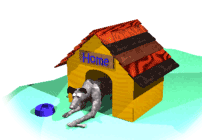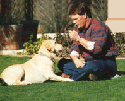 |
|||
|
|
 |
 |
|
|
 |
||
|
Logical Order of Training (Pt. 2) - Creating behaviors for Dynamic and Independent Performance. At any stage play, you can see human actors performing highly stylized behaviors, night after night. Each actor knows the specific cues that bring him onstage, trigger his lines and lead him offstage. If any of the actors start to improvise, the whole production is affected. In this sense, a stage play requires the same type of pre-rehearsed precision that is integral to obedience competition. These types of activities test the ability of a human or dog to repeat routines with unerring accuracy while adding personalized nuances that point to exceptional performance. The essence of the behavior is "do it the same way every time." Last month we looked at an order of training that is suited to that type of setting. This month we look at a variation on this theme and how other forms of training require slightly different approaches. While static performances, like stage plays and obedience competition, are difficult because of their "sameness", other types of performance demand dynamic reaction to changing events. An example of this is team sports that require pre-rehearsed actions, combined with periodic communication inside a context of timeliness. In football, for instance, there are elements of precision balanced with moments of shear anarchy. This type of sport requires that an individual simultaneously "use his head" while making sure that he doesn't "lose his head." These action sports demand a different mental awareness than static performances, and as such, require a slightly different style of training. For agility training, fly-ball, herding, ring sport, search and rescue and some aspects of Schutzhund, the need for a dog to keep and use his head is critical. While obedience training requires the handler to hold pre-learned postures and ritualized motions, dynamic dog sports often require the dog to be out front. These sports usually require the handler to select the behavior, while the dog must apply the command to a changing set of circumstances. The interaction between handler, dog and environment is the essence of these sports. For instance, in agility competition, an agility handler may cue her dog to take the "dog walk" while the animal is dismounting the "A-frame." The dog is required to take the direction of the handler, correctly complete the current behavior and then automatically move to the designated obstacle. The critical instant for the dog is at the tail end of the obstacle, when the dog must check with the handler and listen or watch for another cue. The dog must go from completely ignoring the handler to completely paying attention to the handler - repeatedly. This process is significantly different from more static brands of obedience, and therefore places additional importance on the dog's recognition of cues and signals. (For the sake of clarity, I will confine the rest of my examples to agility training.) Here's an adaptation of teaching that works well for dynamic performances. Note: Last month I mentioned the use of unpleasant consequences for failure to do a behavior or perform the behavior correctly. You may notice that dynamic sports require a slightly different application of the same principle. 1) Shape the behavior. Just as with any other training, the first place to start is with shaping the fundamental behaviors that are required to do the activity. In most action sports, performing the behavior is often sufficient motivation to both shape and maintain the behavior. Other dogs may need to have external reinforcement, such as food, affection, balls or tug toys. The type of reinforcement used does not significantly affect the order or method of training. 2) Add a cue. The process of adding a cue to a dynamic behavior is more complex than static forms like utility signals. Start by attaching the cue as always - present the cue, get the behavior to happen and reinforce the pattern. Once you have relatively good control over the cue, start adding movement to it. For instance, if you are teaching the dog to take jumps, the cue "over" can be given from a stationary position. Once the dog is fairly reliable, move about 15 feet away from the jump. Run with the dog to the point where you have been getting consistently good results. Give the cue AS you are running. Over a series of repetitions, start lagging behind a little bit. Soon, the sound of your voice, from behind, will trigger the behavior. 3) Vary the reinforcement. If your dog runs agility obstacles just for the fun of it, this may dramatically limit your ability to vary the reinforcement. There are two things you can do to help alleviate this problem. First, from the very beginning of your training, you must have a signal that means "you don't get to proceed to the next obstacle - you blew it. " Obviously, if you don't have a way to limit the dog's ability to reinforce himself, you can't weed out mistakes. You must be willing to stop the whole run, when the dog misses any contact zone. Stopping reinforcement is a powerful way to vary the consequences. In this case, shutting down the run may act as a form of punishment. 4) Use an undesirable consequence for failing to respond to a cue. There are very few dogs who are simply unable to understand how to perform the obstacles in agility and can't learn a cue for each of them. The real problem starts when the dog starts losing his hearing or selectively ignoring your commands. This is a natural process for a dog who is starting to enjoy the exhilaration of running the obstacles with confidence. Ideally, the first time this happens, you will yell your punishment signal (NO!) at the instant the dog fails to respond to the next cue and then follow it with an actual punishment. Depending on the dog, the punishment might be something as simple as a time out. If you are unsure of how to complete this step, I will cover the topic in more detail in the near future. 5) Reinforce correct behavior until the unwanted effects of the punishment have disappeared. After applying some form of harmless punishment for failure to listen to the cue, you will invariably see some confusion on succeeding repetitions. This is the time for lots of positive reinforcement and "encouragement." At first, your dog may be unsure of exactly what caused the punishment. The more you practice the correct behavior, the faster he will know exactly what works and what does not. 6) Integrate the behavior into an unexpected and varied combination of other behaviors. For dynamic performance, it is critical that you keep pushing the speed and variety of the tasks you set for your dog. Creating a regimen that cannot be predicted forces the dog to rely on the handler's cues. Maintaining high performance standards prevents the dog from getting sloppy.
|
||
|
Copyright 1994-2013 Gary Wilkes. All rights reserved.
|
||

